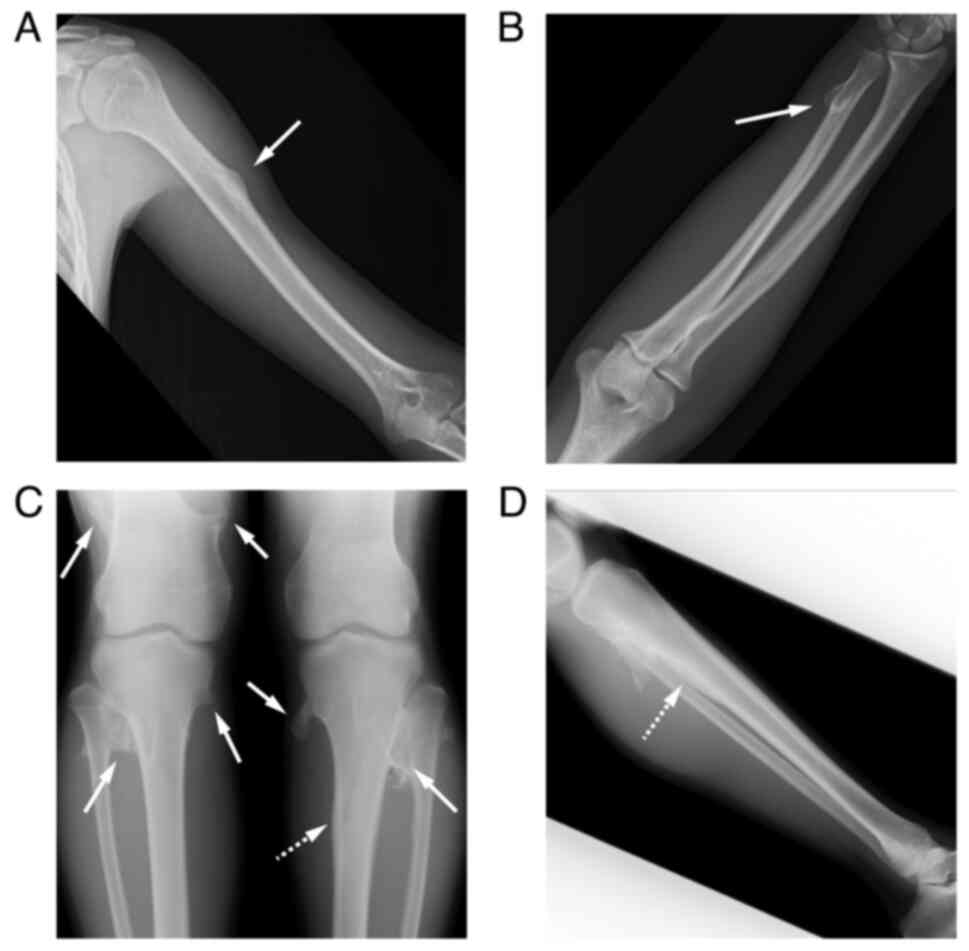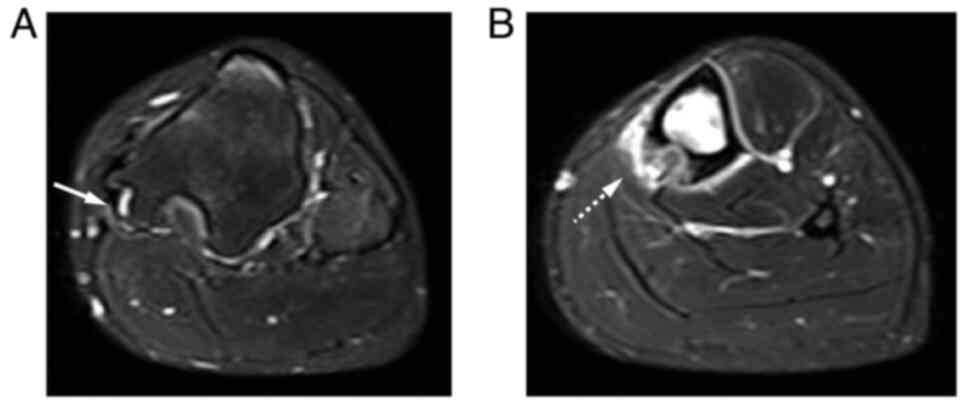|
1
|
Hennekam RC: Hereditary multiple
exostoses. J Med Genet. 28:262–266. 1991.PubMed/NCBI View Article : Google Scholar
|
|
2
|
Bukowska-Olech E, Trzebiatowska W, Czech
W, Drzymala O, Frak P, Klarowski F, Klusek P, Szwajkowska A and
Jamsheer A: Hereditary multiple exostoses-a review of the molecular
background, diagnostics, and potential therapeutic strategies.
Front Genet. 12(759129)2021.PubMed/NCBI View Article : Google Scholar
|
|
3
|
Schmale GA, Conrad EU III and Raskind WH:
The natural history of hereditary multiple exostoses. J Bone Joint
Surg Am. 76:986–992. 1994.PubMed/NCBI View Article : Google Scholar
|
|
4
|
Stieber JR and Dormans JP: Manifestations
of hereditary multiple exostoses. J Am Acad Orthop Surg.
13:110–120. 2005.PubMed/NCBI View Article : Google Scholar
|
|
5
|
Clement ND and Porter DE: Can deformity of
the knee and longitudinal growth of the leg be predicted in
patients with hereditary multiple exostoses? A cross-sectional
study. Knee. 21:299–303. 2014.PubMed/NCBI View Article : Google Scholar
|
|
6
|
Bottner F, Rodl R, Kordish I, Winklemann
W, Gosheger G and Lindner N: Surgical treatment of symptomatic
osteochondroma. A three- to eight-year follow-up study. J Bone
Joint Surg Br. 85:1161–1165. 2003.PubMed/NCBI View Article : Google Scholar
|
|
7
|
Ahn J, Ludecke HJ, Lindow S, Horton WA,
Lee B, Wagner MJ, Horsthemke B and Wells DE: Cloning of the
putative tumour suppressor gene for hereditary multiple exostoses
(EXT1). Nat Genet. 11:137–143. 1995.PubMed/NCBI View Article : Google Scholar
|
|
8
|
Stickens D, Clines G, Burbee D, Ramos P,
Thomas S, Hogue D, Hecht JT, Lovett M and Evans GA: The EXT2
multiple exostoses gene defines a family of putative tumour
suppressor genes. Nat Genet. 14:25–32. 1996.PubMed/NCBI View Article : Google Scholar
|
|
9
|
Jones KB, Pacifici M and Hilton MJ:
Multiple hereditary exostoses (MHE): Elucidating the pathogenesis
of a rare skeletal disorder through interdisciplinary research.
Connect Tissue Res. 55:80–88. 2014.PubMed/NCBI View Article : Google Scholar
|
|
10
|
Fei L, Ngoh C and Porter DE:
Chondrosarcoma transformation in hereditary multiple exostoses: A
systematic review and clinical and cost-effectiveness of a proposed
screening model. J Bone Oncol. 13:114–122. 2018.PubMed/NCBI View Article : Google Scholar
|
|
11
|
Lee EH, Shafi M and Hui JH: Osteoid
osteoma: A current review. J Pediatr Orthop. 26:695–700.
2006.PubMed/NCBI View Article : Google Scholar
|
|
12
|
Zeng H, He H, Tong X, Wang Z, Luo R and
Liu Q: Osteoid osteoma of the proximal femur: Pitfalls in diagnosis
and performance of open surgical resection. Front Surg.
9(922317)2022.PubMed/NCBI View Article : Google Scholar
|
|
13
|
Zhang Y and Rosenberg AE: Bone-forming
tumors. Surg Pathol Clin. 10:513–535. 2017.PubMed/NCBI View Article : Google Scholar
|
|
14
|
Hasegawa T, Hirose T, Sakamoto R, Seki K,
Ikata T and Hizawa K: Mechanism of pain in osteoid osteomas: An
immunohistochemical study. Histopathology. 22:487–491.
1993.PubMed/NCBI View Article : Google Scholar
|
|
15
|
Greco F, Tamburrelli F and Ciabattoni G:
Prostaglandins in osteoid osteoma. Int Orthop. 15:35–37.
1991.PubMed/NCBI View Article : Google Scholar
|
|
16
|
Fittall MW, Mifsud W, Pillay N, Ye H,
Strobl AC, Verfaillie A, Demeulemeester J, Zhang L, Berisha F,
Tarabichi M, et al: Recurrent rearrangements of FOS and FOSB define
osteoblastoma. Nat Commun. 9(2150)2018.PubMed/NCBI View Article : Google Scholar
|
|
17
|
de Ga K, Bateni C, Darrow M, McGahan J,
Randall RL and Chen D: Polyostotic osteoid osteoma: A case report.
Radiol Case Rep. 15:411–415. 2020.PubMed/NCBI View Article : Google Scholar
|
|
18
|
Schajowicz F and Lemos C: Osteoid osteoma
and osteoblastoma. Closely related entities of osteoblastic
derivation. Acta Orthop Scand. 41:272–291. 1970.PubMed/NCBI View Article : Google Scholar
|
|
19
|
Aynaci O, Turgutoglu O, Kerimoglu S, Aydin
H and Cobanoglu U: Osteoid osteoma with a multicentric nidus: A
case report and review of the literature. Arch Orthop Trauma Surg.
127:863–866. 2007.PubMed/NCBI View Article : Google Scholar
|
|
20
|
Beck SE, Schwab JH, Rosenthal DI,
Rosenberg AE and Grottkau BE: Metachronous osteoid osteoma of the
tibia and the T7 vertebral body: A case report. J Bone Joint Surg
Am. 93(e73)2011.PubMed/NCBI View Article : Google Scholar
|
|
21
|
Larsen LJ, Mall JC and Ichtertz DF:
Metachronous osteoid-osteomas: Report of a case. J Bone Joint Surg
Am. 73:612–614. 1991.PubMed/NCBI
|













